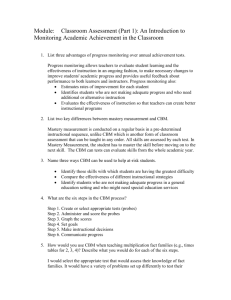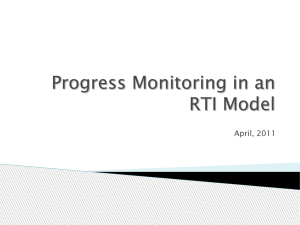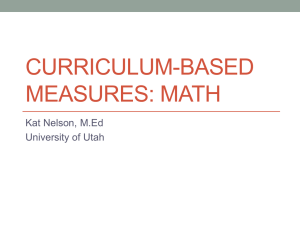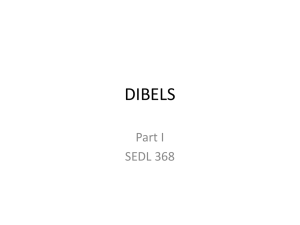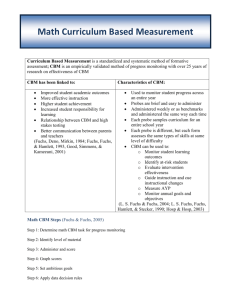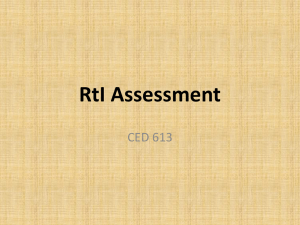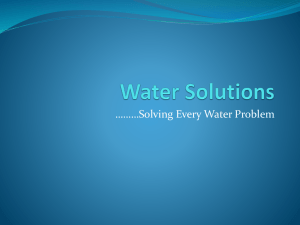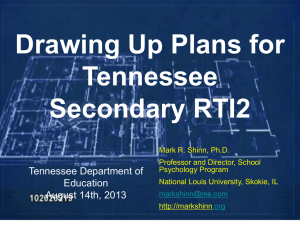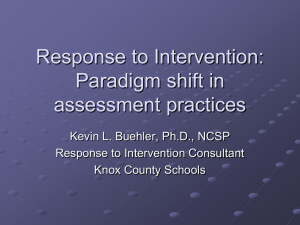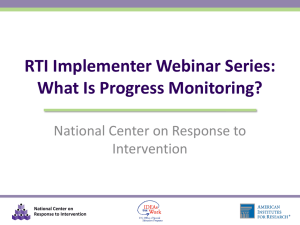Reading Assessment
advertisement
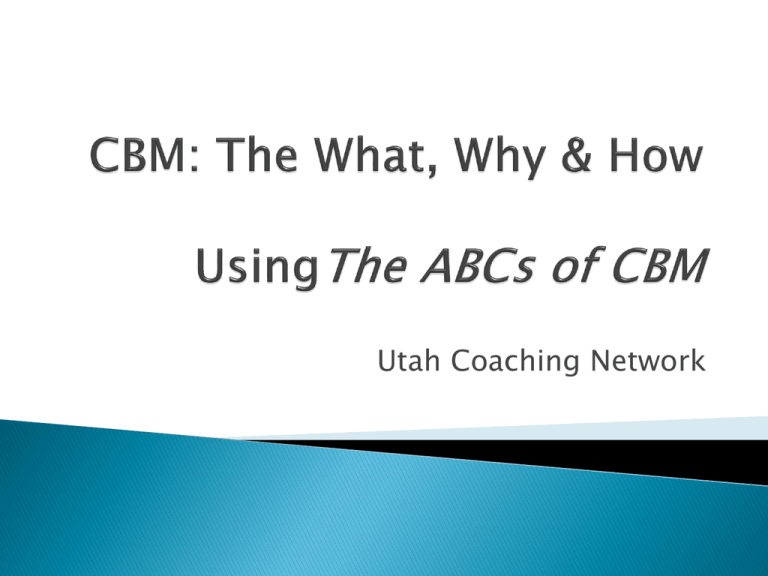
Utah Coaching Network The ultimate goal of assessment is to identify problems with instruction and to lead to instructional modifications. A good share of present-day assessment activities consist of little more than meddling…We must use assessment data to improve instruction…The only way to determine the effectiveness of instruction is to collect data. Ysseldyke and Algozzine (1995) Curriculum-Based Measurement: Introduction Increase knowledge and skills in curriculumbased measurement (CBM) Learn levels of assessment & associated purposes Learn how to administer CBM in reading & math Apply knowledge of CBM to diagnostic assessment practices ◦ Learn can’t do/won’t do assessment ◦ Learn survey level assessment Learn goal setting formula Explore interventions options Apply graphing techniques Analyze data Consider coaching practices Enjoy the journey! Formative assessment Measure of student performance over time An analysis of specific skill on an individual student Tool ◦ ◦ ◦ ◦ ◦ ◦ Identifying struggling students Set goals Align instruction with desired outcomes Provides diagnostic information Progress monitor IEP development Goal is two-fold: 1. Monitor student progress 1. Inform instruction / teacher practice Measure of class-wide performance An alternative to other assessment procedures– often replaces costly, timeconsuming, disruptive practices Quick & Easy Establishes reliability & validity Direct low-inference measures Can be easily summarized & presented ◦ Parents, students, colleagues Benchmarking Diagnostic ◦ Can’t do/won’t do ◦ Survey Level Assessment ◦ Error analysis ◦ Intervention development Progress Monitoring Instructional/criterion-referenced When? How Often? Who? How? What is the purpose? Tier 3 Tier 2 Tier 1 Adapted from Burns & Riley-Tillman (2010) Tier III – Identify discrepancy for individual. Identify causal variable. Implement individual intervention. Tier II – Identify discrepancy for individual. Identify category of problem. Assign small group solution. Tier I – Identify discrepancy between expectation and performance for class or individual. Adapted from Burns & Riley-Tillman (2010) Step 1 Step 2 Step 3 Additional Diagnostic Assessment All students at a grade level Individual Diagnostic Winter Step 4 Results/Monitoring Individual Instruction Weekly Intensive 5% Universal Screening Fall Instruction/In tervention Group Diagnostic Small Group Differentiated by Skill Targeted 15% Spring 2x month None Universal 80% Continue with Core Instruction Benchmarks Grades Classroom Assessments Utah CRT 1. Focus on the curriculum – but also designed to function in problem-solving paradigm What does this look like? 2. Using alterable variables – changed through instruction What does this look like? 3. Employing low-inference measures 4. Employing criterion-referenced measures – the “what” & “how” to teach What does this look like? What does this look like? One-minute probe (e.g., DIBELS, 6-min. Solution) Administered individually Provide intervention and progress monitor at instructional level Different measures ◦ Oral Reading Fluency (ORF) ◦ Maze (Comprehension) ◦ Early-reading (Initial Sound, Phoneme Segmentation, Nonsense Word, Letter Naming Fluency) (See Chapters 3 & 4 in ABCs of CBM) Select appropriate material for probe Place probe in front of and facing the student Keep copy for the examiner (on clipboard) Provide directions Start timer Have student perform task for allotted time (1 minute for reading tasks) Score probe Display data on graph/chart Video Clips . . . . Examples Triads work together Administer reading fluency probe Score probe – count number correct and number of errors Record the score Switch roles & repeat Questions & answers – feedback Oral Reading Fluency: ◦ Mark as correct # of words read correctly in one minute ◦ Mark as incorrect: Misread words Omissions Hesitations - words read by assessor (read after 3 seconds) Reversals – two or more words not read in order (see page 146 in ABCs of CBM) Benchmarks - Table 3.4 (p. 48) Norms – Table 3.5 (p. 49) Growth Rates – Table 3.2 (p. 47) ◦ greater progress is possible If student doesn’t make adequate progress, it doesn’t mean she lacks the ability to learn reading– it means instruction needs to be changed! Math CBM can be broken into three areas: ◦ Early numeracy ◦ Computation ◦ Concepts and Applications Focus will be on administering, scoring, and using CBM for Computation Math CBM is conducted having students answer computational problems for two minutes Count correct digits – NOT correct problems Use standardized procedures Have necessary materials ◦ ◦ ◦ ◦ ◦ ◦ Different but equivalent math sheets Directions for administration Writing utensils Stopwatch Quiet environment Scoring rules & procedures Select appropriate material for probe Place probe in front of and facing the student Can be administered individually or as an entire class Provide directions Start timer Have student perform task for allotted time (2 minutes for math tasks) Score probe Curriculum-Based Measurement: Introduction First time administration ◦ have three equivalent math sheets ◦ Recommend doing it in one session ◦ Median score of three samples used for baseline (first data point on graph) Every time ◦ ◦ ◦ ◦ Standardized procedures (see pg 156) Count correct digits Record on graph Use for decision making Triads work together Review math fluency probes Score probe – count number correct and number of errors Record the score Questions & answers – feedback Curriculum-Based Measurement: Introduction Correct answers . . . ◦ Correct used ◦ Correct ◦ Correct ◦ Correct answers gets credit for longest method digits for unfinished problem digits for reversed or rotated digits digits for placeholder – any symbol! Errors ◦ Mark with slash (/) More sensitive measure for changes in student learning Considered a fairer metric – students awarded more points for correctly solving more complex problems Greater number of points is available for great time commitment on more complex problems Let’s consider the options – see Figure 7.4 (page 105) Benchmarks - Table 7.1 (p. 109) Norms – Table 7.3 (p. 111) Growth Rates – Table 7.1 (p. 109) ◦ greater progress is possible If student doesn’t make adequate progress, it doesn’t mean she lacks the ability to learn math – it means instruction needs to be changed! Math often has a specific scope & sequence that can vary from state to state, school to school, or curriculum to curriculum Educators often create math sheets linked to the state’s core – progress monitoring aligned with outcome measure! Math sheets should have different problems but equivalent difficulty Can be purchased or created Items on sheet not in order presented in curriculum Similar item types are grouped diagonally – assists when looking for patterns in student responses (see page101) Consider mixed vs. single skill Single-skill sheet helpful for short-term planning – used to gain some diagnostic information & assist in decision making General Outcome Measures (GOMs) – used to sample performance across several goals by using “capstone” tasks that are complex (p.11) Skills-based Measures (SBMs) – used to screen, progress monitor, & do survey-level assessment where “capstones” not available (p. 12) Mastery Measures (MM) – used on parts of curriculum that contain discrete and easily identified sets of items (p.13) Purpose ◦ Determine motivation vs. skill deficit Technique ◦ Administer same probe – add incentive ◦ Timing - Soon after benchmark/screener Decision Rules >=15% increase=motivation (Witt & Beck, 1999) <15% skill deficit Consider both Triad practice ◦ Score (p. 48 Benchmarks) ◦ Can’t/Won’t? ◦ Decision? Trial 1 (reading): ◦ Annie: 4th grade 65 cwpm (Fall) Trial 2 (math): ◦ Ethan: 2nd grade 11 cd (Winter) Trial 3 (math): ◦ Trevor: 2nd grade 4 cd (Fall) Purposes ◦ To determine the appropriate instructional placement level for the student. The highest level of materials that the student can be expected to benefit from instruction. ◦ To provide baseline data, or a starting point, for progress monitoring In order to monitor progress toward a future goal, you need to know how the student is currently performing. 1. Start with grade level passages/worksheets (probes) 2. Administer 3 separate probes (at same level of difficulty) using standard CBM procedures. 3. Calculate the median score (i.e. the middle). 4. Is the student’s score within instructional range? ◦ Yes - This is the student’s instructional level. ◦ No - If above level (too easy), administer 3 probes at next level of difficulty. ◦ No - If below level (too hard), administer 3 probes at previous level of difficulty. Refer to Case Studies Provided . . . ◦ Completed Forms B. Blue Jack Horner Sample One – Junie B. – Whole Class Sample Two – Tom - Partner Sample Three – Arthur - Independent Consider instructional levels for sample cases Kindergarten – Letter sound fluency (LSF) Grade 1 – Oral reading fluency (ORF) and/or word identification fluency (WIF) Grade 2 – Oral reading fluency (ORF) Grade 3 – Oral reading fluency (ORF) Grade 4+ - Oral reading fluency (ORF) & mazes See Chapters 3 & 4 Norms ◦ Compare student’s score to the performance of others in her grade or at her instructional level ◦ Data collected on thousands of students – numbers are very similar Growth Rates ◦ Provide an indication of the average number of words per week we would expect students to improve ◦ Not necessarily new words - students reading same words at a faster rate each week 1. Start with grade level math worksheets (probes) 2. Administer 3 separate probes (at same level of difficulty) using standard CBM procedures. 3. Calculate the median score (i.e. the middle). 4. Is the student’s score within instructional range? ◦ Yes - This is the student’s instructional level. ◦ No - If above level (too easy), administer 3 probes at next level of difficulty. ◦ No - If below level (too hard), administer 3 probes at previous level of difficulty. Refer to Case Studies Provided . . . Sample One - Junie B. – Whole Class Sample Two – Tom – Partner Sample Three -Arthur– Independent Consider instructional levels for sample cases Grade 1 – Addition, subtraction Grade 2 – Addition, subtraction Grade 3 – Addition, subtraction, multiplication, division Grade 4+ - Multiplication, division All Grades – Mixed-math skills Secondary – consider common assessments based on state or district core It is our obligation to fix the problem! ◦ Build up prerequisite skills ◦ Increase length of daily lesson ◦ Alter way we respond when error is made We do NOT lower expectations! “Learning is a result of instruction, so when the rate of learning is inadequate, it doesn’t always mean there is something wrong with the student. It does mean the instruction needs to be changed to better meet the student’s needs.” (p. 47) Three considerations: ◦ 1. Purpose – screening vs. progress mon. ◦ 2. Importance of task – learning to read vs. learning Roman numerals ◦ 3. Significance of problem – student’s difficulty increases need effective instruction need more frequent monitoring 1. End of Year Benchmarks 2. Norms - Levels of performance 3. Rate of progress – goal setting ◦ (# of weeks x growth rate) + median baseline = goal Students with greatest deficits need steepest slopes – more intense & effective interventions Case Study # 1 ◦ Jack – 4th grader – reading data ◦ 3rd grade level 78/2, 4th grade level 71/ 3 ◦ compute for 10 weeks and annual goal Case Study # 2 ◦ Suzie – 5th grader – math data ◦ Multiplication 31 CD, division 22 CD ◦ Compute for 10 weeks and annual goal One of the main benefits of CBM is the data are easily displayed in graphs & charts ◦ Standard Graph for CBM line graph ◦ Vertical axis = skill being measured ◦ Horizontal axis = time or sessions Time Axis + Skill Axis Record Changes in Student Learning Over Time Data on student level of performance Data on student rate of progress • How well student Performance can do task Progress • How quickly student is learning how to perform task Baseline Y Axis Label X Axis Label Aim Line - Goal Data Points Intervention Line Intervention Line Label Change Line Change Line Label Level of material being used Student demographics Peer Reading Sight word practice Data Point Analysis – “If-Then Rules” ◦ 3-4 successive data points above the aim line – move on (add “weight”) ◦ 3-4 successive data points below the aim line – change intervention to boost learning ◦ 3-4 successive data points lie around the aim line – make no changes By hand 5-Clicks in Excel www.InterventionCentral.com www.updc.org ◦ CBM Focus ◦ PM Focus Graph individual data ◦ Include all components of a graph so it “stands alone” ◦ Chart your data and progress monitoring data Remember labels Adapted from Burns & Riley-Tillman (2010) A Few “Go To” Interventions . . . Inaccurate and Fluid: Drill and overcorrection (pg 101-105) Nuclear reading w/overcorrection Accurate and Slow: Peer tutoring (pg 145-149) Repeated reading Nuclear intervention Inaccurate and Slow: Response cards for increasing letter/letter sound identification (pg 123-129) Nuclear reading w/ overcorrection DI on sight words, letter sounds, & blending Won’t Do: Mystery Motivator (pg 57-63) Offer treasure chest each day child has beat score Always focus on student outcomes! What will be the objective of the coaching interaction? What tools will you use? How will you measure mastery? What’s the smallest change you can make that results in the biggest outcome??? CBM data are an excellent source for writing goals & objectives CBM data provide information on specific student skills (i.e. ORF, math facts) CBM data are sensitive to student improvement CBM data allow teachers to make instruction decisions RTI is tiered approach to instruction CBM is core component of RTI CBM used throughout all tiers – only change is frequency of assessment Decisions within RTI Approach using CBM Effectiveness of instruction Eligibility for remedial programs (such as special education) ACADEMIC SYSTEMS BEHAVIOR SYSTEMS Tier 3: Comprehensive & Intensive Students who need individualized interventions. Tier 3: Intensive Interventions Students who need individualized intervention. Tier 2: Strategic Interventions Students who need more support in addition to the core curriculum. Tier 2: Targeted Group Interventions Students who need more support in addition to school-wide positive behavior program. Tier 1: Core Curriculum All students, including students who require curricular enhancements for acceleration. Tier 1: Universal Interventions All students in all settings. 63 COACHING 63 10 Steps for using CBM 1. Who will be using CBM? 2. Which skills of CBM will be implemented? 3. What materials will be used? 4. When will implementation start? 5. Who will train the staff? 6. Who will manage the materials? 7. Who will collect the data? 8. Where will the data be collected? 9. Who will manage the data once collected? 10. How will data be shared? (Checklist for Using CBM – pp. 160-161) Increase knowledge and skills in curriculumbased measurement (CBM) Learn levels of assessment & associated purposes Learn how to administer CBM in reading & math Apply knowledge of CBM to diagnostic assessment practices ◦ Learn can’t do/won’t do assessment ◦ Learn survey level assessment Learn goal setting formula Explore interventions options Apply graphing techniques Analyze data Consider coaching practices Enjoy the journey! Updc.org The ABC’s of CBM One-Minute Academic Functional Assessment and Interventions: “Can’t” Do It…or “Won’t” Do It? Functional Assessments: A Step-by-Step Guide to Solving Academic and Behavior Problems Implementing Response-to-Intervention in Elementary and Secondary Schools (Burns & Gibbons, 2008) I’ve DIBEL’d, Now What? AIMSweb.com Interventioncentral.org Pre-Referral Intervention Manual School Problem Solving Teams What Works Clearinghouse: http: //ies.ed.gov/ncee/wwc/ www.Studentprogress.org www.CBMnow.org
